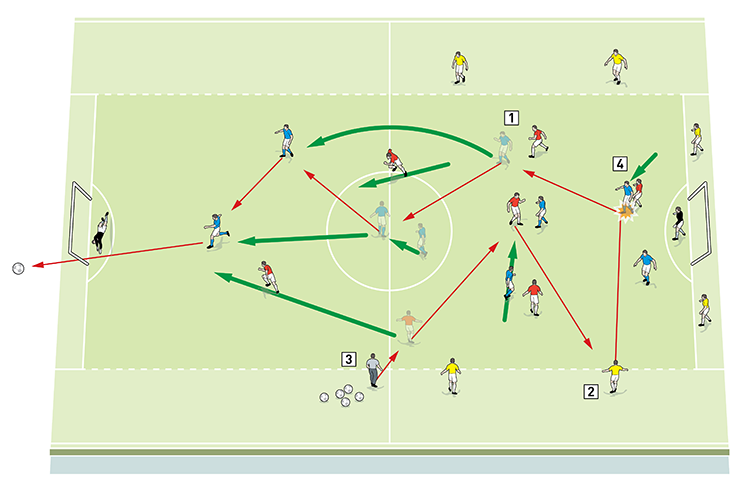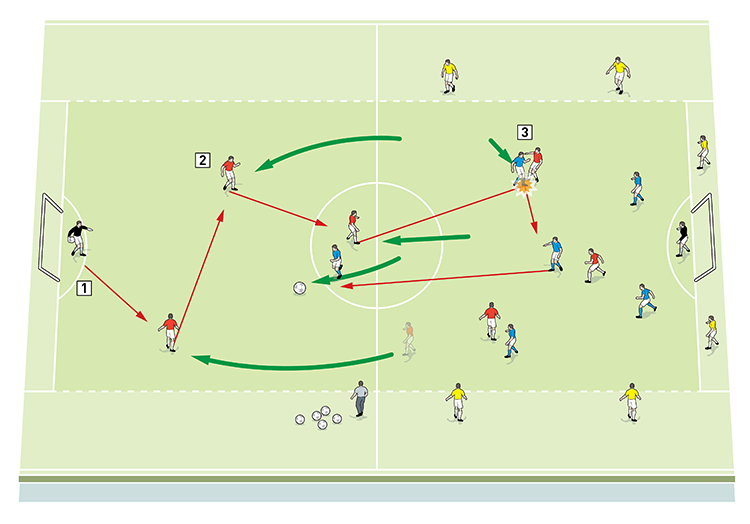




OUR BEST EVER OFFER - SAVE £100/$100
JOIN THE WORLD'S LEADING PROFESSIONAL DEVELOPMENT PROGRAMME
- 12 months membership of Elite Soccer
- Print copy of Elite Player & Coach Development
- Print copy of The Training Ground
You are viewing 1 of your 1 free articles
Counter-attacking
This session is all about counter-attacking and it encourages players to be organised and confident, so that during the transition from defence to attack they are able to quickly commit numbers in behind and in wide areas.
| Area | 70x44 yards |
| Equipment | Balls, bibs, cones, poles, 2 goals |
| No. of Players | 18 players + 2 goalkeepers |
| Session Time |
Counter-attacking practice: 15mins, Progression 1: 15mins, Progression 2: 15mins |
This session is all about counter-attacking and it encourages players to be organised and confident, so that during the transition from defence to attack they are able to quickly commit numbers in behind and in wide areas.
Players like this session because it is game-related and it helps our approach to matches because we feel teams defending deeper is becoming a greater trend in the modern game. It also exaggerates the importance of decision making, improves the detail of passing and requires high quality movement.
We would use this session in the run up to facing a team who commit numbers forward and potentially play with a back three, where they can be vulnerable in wide areas.
What do I get the players to do?
Counter-attacking practice
We set up a playing area of 70x44 yards (or between the two penalty boxes on a normal pitch), with a goal and a goalkeeper at each end. We’re using 18 outfield players. We set up a red attacking team of six and a blue defending/counter-attacking team of six, who both start in the defending half of the pitch. In addition, six yellow neutrals are positioned around the outside of the defending half. The neutrals are one-touch and they can support the team in possession.
Play starts with the coach passing into the attacking team, who must try to score in the goal in that half. The defending team should attempt to win the ball and launch a counter-attack to score in the other half, as shown [1]. We play for 15 minutes.
1

2. Six yellow neutrals are positioned around the outside of the defending half. They are one-touch and they can support the team in possession
3. Play starts with the coach passing into the red attacking team, who must try to score in the goal in that half
4. The blue defending team must win the ball and launch a counter-attack to score in the other half
How do I progress the session?
Progression 1
To progress the activity, we play the same game as before but this time we add three gates halfway between the centre line and the goal that the blues are counter-attacking. The counter-attacking team must pass the ball through one of these gates before they can score, as shown [2]. This is to ask the players for more detail on the pass and to highlight key areas for the counter-attacking team to exploit at speed. We play for 15 minutes.
2

2. On winning the ball, the blue defending team must quickly make the transition to counter-attack
3. The yellows still support from the outside of the defending half and play one-touch for the team in possession
Progression 2
To progress the activity further, we now remove the gates and ask the goalkeeper of the red attacking team to start play with a pass out from the back. As it’s now free play, some of his team mates should drop into their own half to receive the ball from him and they then build an attack into the other half where they must try to score. The blue defending team must now set up to intercept, or tackle to win the ball before it gets into the danger areas. When they win possession, they should counter-attack with speed, as shown [3]. We play for 15 minutes.
3

2. Some of the reds should drop into their own half to receive the ball from the keeper and then build an attack into the other half where they try to score
3. The blue defending team must now set up to intercept or should tackle to win the ball, as here. Then they should counter-attack with speed
How would I put this into a game situation?
As this activity is already a small-sided game, it can easily be progressed into a full 11v11 game with the basic principles of play remaining the same.
What are the key things to look out for?
We want to see the possession team maintaining a high ball speed in order to move the opposition and limit the touches in the opposition half. We particularly want to see teams counter-attacking with width and players creating angles off the ball to help with link play. Players should also make dynamic runs beyond and between the lines to stretch the opposition.
Always make sure that the players continue to pass the ball with quality and detail.
What are the typical mistakes players might make and how do I avoid them?
Players can sometimes rush their decision making, but while the body is racing, the mind should remain calm. Ensure players stay composed through the transition from defence to attack and do not play ‘direct’ because there is space behind.
Related Files
Editor's Picks
Attacking transitions
Deep runs in the final third
Using the goalkeeper in build-up play
Intensive boxes drill with goals
Penetrating the final third
Creating and finishing
My philosophy
Pressing initiation
Compact team movement
Coaches' Testimonials

Alan Pardew

Arsène Wenger

Brendan Rodgers

Carlos Carvalhal

José Mourinho

Jürgen Klopp

Pep Guardiola

Roy Hodgson

Sir Alex Ferguson

Steven Gerrard
Coaches' Testimonials

Gerald Kearney, Downtown Las Vegas Soccer Club

Paul Butler, Florida, USA

Rick Shields, Springboro, USA

Tony Green, Pierrefonds Titans, Quebec, Canada
Join the world's leading coaches and managers and discover for yourself one of the best kept secrets in coaching. No other training tool on the planet is written or read by the calibre of names you’ll find in Elite Soccer.
In a recent survey 92% of subscribers said Elite Soccer makes them more confident, 89% said it makes them a more effective coach and 91% said it makes them more inspired.
Get Monthly Inspiration
All the latest techniques and approaches
Since 2010 Elite Soccer has given subscribers exclusive insight into the training ground practices of the world’s best coaches. Published in partnership with the League Managers Association we have unparalleled access to the leading lights in the English leagues, as well as a host of international managers.
Elite Soccer exclusively features sessions written by the coaches themselves. There are no observed sessions and no sessions “in the style of”, just first-hand advice delivered direct to you from the coach.







